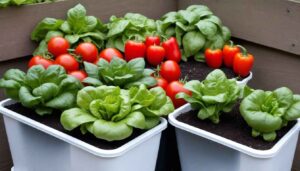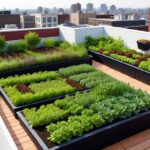Transforming your rooftop into a lush garden sanctuary through rooftop gardening is not only rewarding but also beneficial for the environment and your well-being. Whether you have a sprawling rooftop terrace or a cozy urban balcony, creating a garden in the sky is easier than you think. In this comprehensive guide, we’ll walk you through everything you need to know to start your rooftop gardening journey, from selecting the right plants to making your own compost.
Section 1: Choosing the Right Plants for Rooftop Gardening
One of the most critical aspects of rooftop gardening is selecting plants that thrive in your specific climate and rooftop conditions. Here are some key considerations and excellent plant options for rooftop gardens:
1.1 Considerations for Rooftop Plants:
- Sunlight Exposure: Assess the amount of sunlight your rooftop receives throughout the day and choose plants that can tolerate full sun or partial shade.
- Wind Exposure: Rooftops are often windier than ground-level gardens, so select plants that can withstand strong winds without toppling over or drying out.
- Space Constraints: Since rooftop gardens typically have limited space, opt for plants that grow well in containers and don’t require extensive root systems.
1.2 Recommended Plants for Rooftop Gardening:
- Herbs: Basil, rosemary, thyme, and mint are excellent choices for rooftop gardens, as they require minimal space and can be harvested frequently for culinary use.
- Vegetables: Tomatoes, peppers, lettuce, and spinach thrive in containers and can provide a bountiful harvest throughout the growing season.
- Flowers: Marigolds, petunias, and pansies not only add beauty to your rooftop garden but also attract pollinators like bees and butterflies.

Section 2: Essential Supplies for Rooftop Gardening
Before you embark on your rooftop gardening journey, gather the necessary supplies to ensure success:
2.1 Containers:
Choose lightweight, weather-resistant containers with proper drainage to prevent waterlogging and facilitate airflow around the roots of your plants.
2.2 Potting Mix:
Invest in high-quality potting mix that provides adequate nutrients and drainage for your plants. Avoid using garden soil, as it may compact in containers and hinder plant growth.
2.3 Watering Can or Hose:
Ensure easy access to water for regular irrigation, especially during hot summer months. Consider installing a drip irrigation system to efficiently water your rooftop garden.
2.4 Tools:
Basic gardening tools such as a trowel, pruning shears, and gloves will come in handy for planting, pruning, and maintenance tasks.
Section 3: Creating DIY Compost for Rooftop Gardening
Composting is a sustainable way to nourish your rooftop garden while reducing waste. Follow these steps to make compost at home:
3.1 Select a Compost Bin:
Choose a suitable container for composting, such as a bin or a designated area on your rooftop. Ensure that the bin has adequate airflow and drainage to facilitate the composting process.
3.2 Add Organic Materials:
Collect kitchen scraps, yard waste, and other organic matter like leaves and grass clippings. Avoid adding meat, dairy, and oily foods to prevent foul odors and attract pests.
3.3 Layering:
Alternate between green materials (e.g., fruit and vegetable scraps) and brown materials (e.g., dried leaves and newspaper) to create a balanced compost pile. Aim for a ratio of approximately 3 parts brown materials to 1 part green materials.
3.4 Aeration and Moisture:
Turn the compost regularly to aerate it and facilitate the decomposition process. Maintain proper moisture levels by watering occasionally, ensuring that the compost pile remains damp but not waterlogged.
3.5 Patience:
Composting is a gradual process, so be patient and allow time for the materials to decompose into nutrient-rich compost. Depending on various factors such as temperature and moisture levels, composting can take several weeks to several months.
Section 4: Maintenance Tips for Rooftop Gardening
To ensure the success of your rooftop garden, follow these maintenance tips:
4.1 Regular Watering:
Check the moisture levels of your soil regularly and water your plants as needed, especially during dry periods. Consider using a moisture meter to accurately gauge soil moisture levels.
4.2 Fertilization:
Supplement your plants with organic fertilizers or compost tea to provide essential nutrients and promote healthy growth. Avoid over-fertilizing, as it can lead to nutrient imbalances and damage to your plants.
4.3 Pruning and Harvesting:
Regularly prune back overgrown foliage to maintain the shape and health of your plants. Harvest ripe fruits and vegetables promptly to encourage continuous growth and prevent overcrowding.
4.4 Pest Control:
Keep an eye out for pests and diseases, and address any issues promptly using natural remedies or organic pesticides. Consider attracting beneficial insects like ladybugs and lacewings to help control pest populations.
Embark on your rooftop gardening journey with confidence, armed with the knowledge and tips provided in this guide. Whether you’re a seasoned gardener or a novice enthusiast, creating a rooftop garden is a fulfilling experience that brings nature closer to home. Start small, experiment with different plants and techniques, and watch your rooftop oasis flourish.
Also Read: Fairy Garden Ideas for Landscaping Garden Fountains








